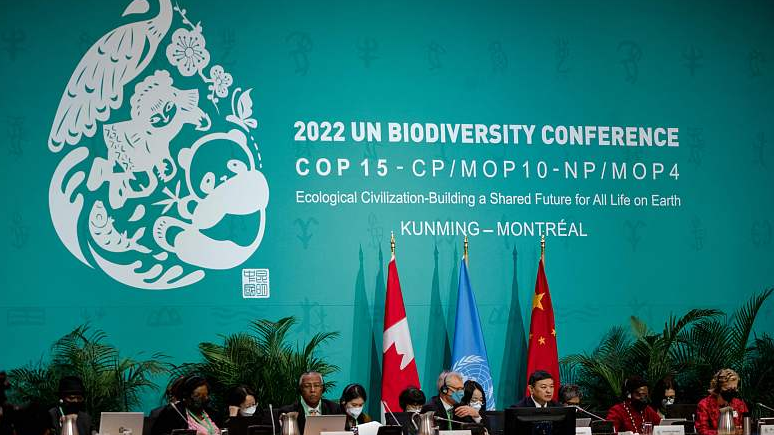
The opening ceremony of the second phase of the 15th meeting of the Conference of the Parties to the UN Convention on Biological Diversity (COP15) in Montreal, Canada, December 7, 2022. /Xinhua
The opening ceremony of the second phase of the 15th meeting of the Conference of the Parties to the UN Convention on Biological Diversity (COP15) in Montreal, Canada, December 7, 2022. /Xinhua
Editor's note: Wei Fuwen is an academician of the Chinese Academy of Sciences and a professor in wildlife ecology and conservation biology. The article reflects the author's opinions and not necessarily the views of CGTN.
Biodiversity is the foundation for the Earth's health, the future of humanity, the basis for sustainable social and economic development, as well as for ecological security, food security and human health. The post-2020 global biodiversity framework is expected to be adopted at the second phase of the 15th Meeting of the Conference of the Parties (COP15) to the United Nations Convention on Biological Diversity (CBD) in Montreal, Canada. It's an ambitious plan for the next decade requiring strong action to halt the dramatic loss of biodiversity and place it on the road to recovery.
As host country of COP15, China attaches much significance to biodiversity conservation, adhering to the construction of ecological civilization, accelerates the mainstreaming of biodiversity in all fields, and promotes the restoration and protection of ecosystems by implementing ecological protection projects and other measures. China has performed productive work in biodiversity protection.
As pointed out by Chinese President Xi Jinping via a video link at the opening ceremony of the second phase of COP15, China has promoted ecological progress and biodiversity protection. Many rare and endangered species have been placed under effective protection, and the diversity, stability and sustainability of the ecosystem have kept improving. We support biodiversity protection with Chinese characteristics.
The Chinese government is advancing Ecological Civilization (EC), which draws upon the ancient Chinese notion of "unity of nature and human" and "follow nature's course" to explain the interdependence between humans and nature. Ecological civilization must be incorporated into advancing the economic, political, cultural, and social progress. The principles of EC align with the three objectives of the CBD, as well as the United Nations' Sustainable Development Goals (SDGs) that are compatible with the 2050 Vision "living in harmony with nature."
China endorses the research of conservation biology, which could provide scientific and technological support for decision-making related to the conservation of biodiversity and endangered species. Take the giant panda as an example, Chinese scientists have used multidisciplinary methods, including molecular biology and genomics and discovered that in order to adapt to changes in feeding habits, giant pandas have undergone changes in morphology, behavior, genetics and intestinal microbes, forming adaptive evolutionary mechanisms. Population genomics was used to reconstruct the fluctuation and differentiation history of the giant panda population to elucidate the endangered process and causes. The non-invasive genetic analysis system of the giant panda was established, and they were found to have high genetic diversity and stable population growth, indicating the giant panda still has evolutionary potential, which eliminates people's concerns over the future of this species.

Giant pandas play at the Daxiangling Nature Reserve, southwest China's Sichuan Province, December 23, 2021. /CFP
Giant pandas play at the Daxiangling Nature Reserve, southwest China's Sichuan Province, December 23, 2021. /CFP
China has established a system of wildlife protection and protected areas to support biodiversity conservation. China has opened over 10,000 protected areas of various types, accounting for about 18 percent of its land area. With regard to ex-situ protection, about 200 botanical gardens and 250 wildlife rescue and breeding centers were founded, covering more endangered species. The wild populations of Przewalski's horse and Pere David's deer that were once extinct in the wild in China have been recovered. Nearly 100 species of critically endangered wild plants such as Cycas debaoensis have been protected, and about 120 species of rare plants have returned to the wild. Flagship species such as the giant panda, snow leopard and crested ibis have recovered from the brink of extinction, with their IUCN Red List ratings downgraded from Endangered to Vulnerable or from Critically Endangered to Endangered.
China has strengthened biodiversity mainstreaming and incorporated biodiversity into its overall planning for economic and social development, ecological protection and restoration, land use, as well as its special plans. China has placed biodiversity conservation high on the agenda, codifying it into the 13th Five-Year Plan for Economic and Social Development (2016-2020). In June 2021, China unveiled a 15-year comprehensive plan for ecosystem management entitled, "Master Plan for Major National Ecological System Protection and Restoration Projects (2021-2035)."
Strictly observing the Ecological Conservation Redline (ECR) is the major innovation. The ECR has been adopted and extended to the marine field. The ECR could protect more than 95 percent of China's most valuable ecosystems, 100 percent of the habitats of plants and animals under state key protection, 95 percent of the best natural landscape resources, the headwaters of 210 important rivers, and all ecologically fragile areas and ecological functional areas.
China's biodiversity conservation practices offer solutions for the international community. China stands ready to share its experience in ecological civilization construction and biodiversity conservation with all parties, remains committed to building a community with a shared future for humanity, take part in global biodiversity governance and contribute to global ecological civilization and to a shared future for all life on Earth.
(If you want to contribute and have specific expertise, please contact us at opinions@cgtn.com. Follow @thouse_opinions on Twitter to discover the latest commentaries in the CGTN Opinion Section.)